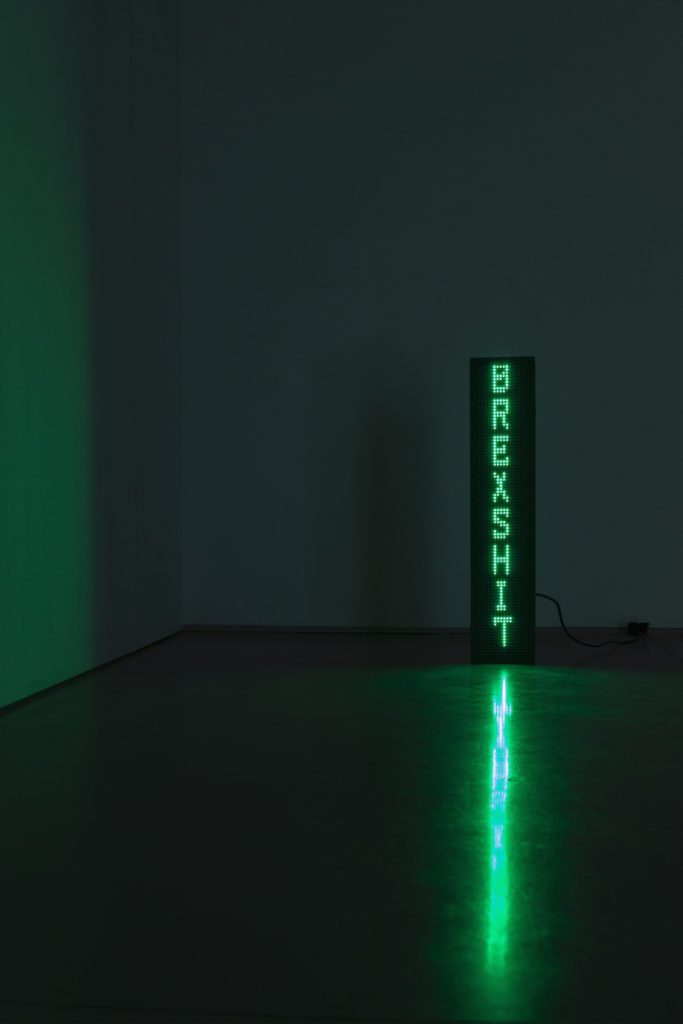The Brexshit Machine
サイモン・ロバーツ
Simon Roberts
23 December, 2020 – 7 March, 2021
The Brexshit Times (limited edition, 1000)
© Simon Roberts, 2020. The Brexshit Machine. LED sign, 40 x 8 x 1.6 inches.
.
|
ブレグザゲドン、ブレグザポカリクス、ブレグジレント、ブレグコーシス、ブレクスクレメント、ブレグゼノミクス、ブレグスファクター、ブレグゾーシテッド、ブレグザイエティ、ブレグザイルズ、ブレグジペイティッド、ブレグジステンシャル、ブレグジタニア、ブレグジテッド、ブレグジティアーズ、ブレグジターニティ、ブレグジテスク、ブレグジティング、ブレグジティッシュ、ブレグジタイツ、ブレグジトクシシティ、ブレグマス、ブレグゾダス、ブレグゾーシスト、ブレグスパッツ、ブレグスプロージョン、ブレグズポカリプス、ブレグシット、ブレグシットショー、ブレグシック、ブレグステンション、ブレグスターナティ、ブレグススルー、ブレグジティンクト
風土と風景の描写を行き来するサイモン・ロバーツは、地政学や文化的アイデンティティについての思索を表現する手段として、写真を選択することが多い。頓知とユーモアを交え、寓話的な作風もって人と空間との関係性を描いたブリューゲルの絵画のように、ロバーツの作風も、写真中に人を点在させるなど、絵画的構成を取ることによって奥行きを感じさせる描写法が高い評価を得ている。社会や文化はアイデンティティや帰属意識から形成されるが、ロバーツは、共通歴史、集合的記憶、共愛など、文化地理的概念が社会に与える影響について、深い関心を抱いている。 森羅万象の美しさとは有機的で不完全なもので、人に関しては癖や短所から生まれるものであるとロバーツは理解しており、彼はその見識のもと、生粋のイギリス人らしく、冗談と遊び心もって、人や社会の欠陥を巧妙に表している。ロバーツの描写は何かに対する考証なのか、ただの肖像画法なのか、その間で揺れている。時には特定の出来事を捉えているようなのだが、自然と活動的生によってしか織り成せない、人と場所とモノがぴたりと揃ったかのような、偶然な瞬間や人生のカオスを捉えた作品の方が多い気もしなくはない。 私が特に魅了されるのは、ロバーツの、自身の芸術の「民主化」への熱心である。新たなアイディアを推進するためのクラウドファンディングや、公的な議論ができるプラットフォーム構築の支援などの幅広い活動がある。それらは、物事の概念性と公共性が交錯し、愛国心とナショナリズムが再定義されるきっかけをもたらしているとともに、21世紀の社会情勢に適った新たな手段により、多様性と非協調性を祝っている。そこから生まれるコミュニティやアイデンティティ 、インクルージョンこそ、社会運動や地域性、人々の勤労と娯しみを可能にし、最終的には文化や政治を表象するものとなるのだ。 イギリスがEU(欧州連合)から離脱するまで残り数日と迫っている今、ザ・コンテナーのささやかな空間にてロバーツの「ブレグシット・マシーン」(くそなブレグジットの構造)を展示できるこのタイミングは、至高だ。緑色のLEDにモノトーンに照らされた「ブレグジット用語」は、2016年に離脱が決まった際、一部イギリス国民の間では離脱後の社会変化に対する不安が高まったことで生まれた、「Brex(ブレグ)」で始まる様々な造語である。作品はイギリスの正式な加盟が終了し、移行期間が始まった2020年1月31日を記念するために作られたが、移行期間が終了する間際、今もなお、多くの「ブレグザイエティ(ブレグジット不安)」が残存している象徴として、ザ・コンテナーにて展示することとなった。作品は、アイデンティティの自己喪失を抱える一国の様子を伝えているだけでなく、変化の瞬間を取り巻く社会議論を捉えている。 本展で使用されている語彙は「ブレグジット・レクシコン(2016-2020)」から抜粋されたもので、ロバーツによれば、「ブレグジットの過程を伝えた見出しや術語のうち、代表的だったものを5000個ほど集めてデータベース化」した編集物である。リサーチとしてロバーツによって編集され、イギリスの来たる日の離脱を考証しながら4年に渡って生み出してきた、数々の作品のベースとなってきた。本カタログでは語彙集全体を再出版することにし、新たに追加された言葉や、ロバーツによってアーカイブ化された画像も含めることとした。語彙集はアルファベット順に並べられているが、その順番は政治家や専門家、メディアが一語一句使用した際に露呈された矛盾やポピュリズム的含意、美辞麗句を批判的思考的に表すためにある。
最後になるが、この度ザ・コンテナーで主催する「ブレグシット・ |
BREXAGEDDON, BREXAPOCALYPSE, BREXCELLENT, BREXCHOSIS, BREXCREMENT, BREXENOMICS, BREXFACTOR, BREXHAUSTED, BREXIETY, BREXILES, BREXIPITATED, BREXISTENTIAL, BREXITANNIA, BREXITED, BREXITEERS, BREXITERNITY, BREXITESQUE, BREXITING, BREXITISH, BREXITITES, BREXITOXICITY, BREXMAS, BREXODUS, BREXORCIST, BREXPATS, BREXPLOSION, BREXPOCALYPSE, BREXSHIT, BREXSHITSHOW, BREXSICK, BREXTENSION, BREXTERNITY, BREXTHROUGH, BREXTINCT
Oscillating between depictions of land and landscape, Simon Roberts usually chooses photography to share his reflections on geopolitics and cultural identity. He is acclaimed for his portrayals of vastness in tableaux-like compositions, with characters at play dotting the surface, not unlike in a Bruegel painting, narrating an allegory, full of wit and humour, of the relationship between persons and place. He has a deep interest in geocultural signifiers such as common history, collective memory, and shared love as a gateway to social impact, where a sense of identity and belonging shapes society and culture. In true British fashion, Roberts is a master of delineating the deficiencies of persons and society, in a tongue-in-cheek playfulness, and with an understanding that beauty derives from the organic and the imperfect, from the quirks and flaws. His depictions lurch between being a documentation and portraiture — sometimes they seem to portray a specific occasion, but more often than not, to document a random passing moment, a picture of the chaos of life, where persons, places, and objects line up in a composition that only nature and human condition can allow. I am fascinated, in particular, by Roberts’s interest in democratising his art: from his crowdsourcing efforts for new ideas to the facilitation of a platform for public discourse, where the conceptual and a communal meet to redefine notions of patriotism and nationalism, in a new 21st-century-relevant fashion, celebrating diversity and nonconformity. The sense of community, a sense of identity and inclusion, enable movement, locality, work, and play — all to tally up as cultural and political currencies. With days before the official separation of the UK from the EU, there is no more timely occasion to present Simon Roberts’s Brexshit Machine in the confined space of The Container. Radiating monotonous “Brexit terms” in green LED letters, all bearing the prefix Brex-, as became ubiquitous in the UK since the decision to separate in 2016, to share the anxieties surrounding this moment of change. The work was initially created to mark 31 January 2020, the day that the UK’s membership of the European Union ended and the start of the “transition period”, and is reinstalled again, at The Container, symbolically at the end of this transition, still with many “brexieties”. The installation doesn’t only paint a portrait of a country during an identity crisis, but also of the discourse surrounding this moment of change. The vocabulary used for the installation is a short excerpt from The Brexit Lexicon (2016-2020), a compiled selection of “notable headlines and terminology that has been used to describe the Brexit progress were gathered together to form a database containing over five thousand individual words,” in Roberts’s words. The Lexicon, collated by Roberts as research, is the foundation for a number of works the artist created in the last four years, examining the imminent break from the European Union. In the catalogue for the exhibition, we are republishing the full lexicon, along with some new additions and also with some images archived by the artist. The lexicon is arranged alphabetically to suggest a critical dictionary where the terms and phrases expose the contradictions, populist, and often rhetoric, vocabulary used by politicians, experts, and the media.
Lastly, the exhibition, ‘The Brexshit Machine’, at The Container is a collaboration with ARTINTRA and as part of the international project “Complex States: Art in the Years of Brexit”, curated by Vassiliki Tzanakou and Catherine Harrington, which examines works by more than thirty artists, in various venues worldwide, as a window on contemporary artist responses to Brexit. |

